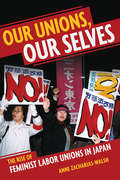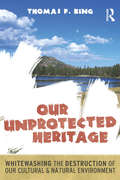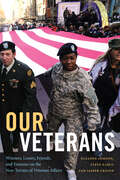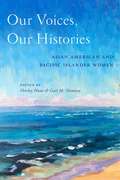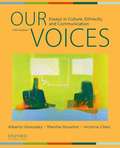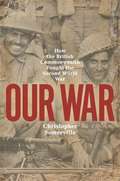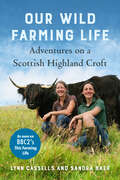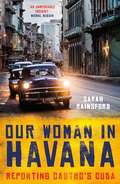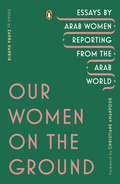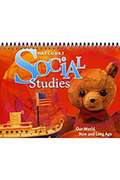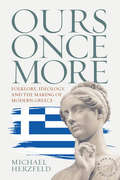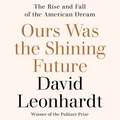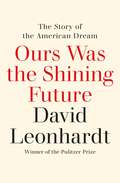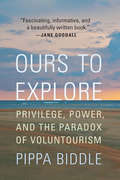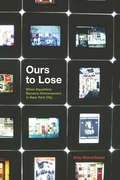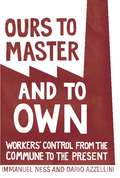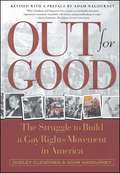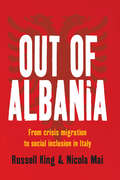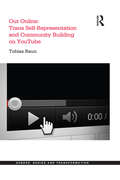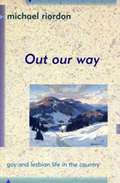- Table View
- List View
Our Unions, Our Selves: The Rise of Feminist Labor Unions in Japan
by Anne Zacharias-WalshIn Our Unions, Our Selves, Anne Zacharias-Walsh provides an in-depth look at the rise of women-only unions in Japan, an organizational analysis of the challenges these new unions face in practice, and a firsthand account of the ambitious, occasionally contentious, and ultimately successful international solidarity project that helped to spark a new feminist labor movement.In the early 1990s, as part of a larger wave of union reform efforts in Japan, women began creating their own women-only labor unions to confront long-standing gender inequality in the workplace and in traditional enterprise unions. These new unions soon discovered that the demand for individual assistance and help at the bargaining table dramatically exceeded the rate at which the unions could recruit and train members to meet that demand. Within just a few years, women-only unions were proving to be both the most effective option women had for addressing problems on the job and in serious danger of dying out because of their inability to grow their organizational capacity.Zacharias-Walsh met up with Japanese women's unions at a critical moment in their struggle to survive. Recognizing the benefits of a cross-national dialogue, they teamed up to host a multiyear international exchange project that brought together U.S. and Japanese activists and scholars to investigate the links between organizational structure and the day-to-day problems nontraditional unions face, and to develop Japan-specific participatory labor education as a way to organize and empower new generations of members. They also gained valuable insights into the fine art of building and maintaining the kinds of collaborative, cross border relationships that are essential to today's social justice movements, from global efforts to save the environment to the Fight for $15 and Black Lives Matter.
Our Unprotected Heritage: Whitewashing the Destruction of our Cultural and Natural Environment
by Thomas F KingMost Americans agree that our heritage—both natural and cultural—should be protected. Then why does development run rampant, aided—rather than limited—by government inaction? Tom King has been a participant in and observer of this system for decades, as a government worker, heritage consultant, and advocate for local communities. In this hard-hitting critique of the heritage-industrial complex, King points the finger at watchdogs who instead serve as advocates, unintelligible (often contradictory) regulations, disinterested government employees and power-seeking agencies, all of whom conspire to keep our heritage unprotected. His solution to this crisis will be uncomfortable to many in power, but may help save more of our cultural and natural treasures.
Our Veterans: Winners, Losers, Friends, and Enemies on the New Terrain of Veterans Affairs
by Suzanne Gordon Steve Early Jasper CravenIn Our Veterans, Suzanne Gordon, Steve Early, and Jasper Craven explore the physical, emotional, social, economic, and psychological impact of military service and the problems that veterans face when they return to civilian life. The authors critically examine the role of advocacy organizations, philanthropies, corporations, and politicians who purport to be “pro-veteran.” They describe the ongoing debate about the cost, quality, and effectiveness of healthcare provided or outsourced by the Department of Veterans Affairs (VA). They also examine generational divisions and political tensions among veterans, as revealed in the tumultuous events of 2020, from Black Lives Matter protests to the Trump-Biden presidential contest. Frank and revealing, Our Veterans proposes a new agenda for veterans affairs linking service provision to veterans to the quest for broader social programs benefiting all Americans.
Our Voices, Our Histories: Asian American and Pacific Islander Women
by Shirley Hune Gail M. NomuraAn innovative anthology showcasing Asian American and Pacific Islander women’s histories Our Voices, Our Histories brings together thirty-five Asian American and Pacific Islander authors in a single volume to explore the historical experiences, perspectives, and actions of Asian American and Pacific Islander women in the United States and beyond. This volume is unique in exploring Asian American and Pacific Islander women’s lives along local, transnational, and global dimensions. The contributions present new research on diverse aspects of Asian American and Pacific Islander women’s history, from the politics of language, to the role of food, to experiences as adoptees, mixed race, and second generation, while acknowledging shared experiences as women of color in the United States. Our Voices, Our Histories showcases how new approaches in US history, Asian American and Pacific Islander studies, and Women’s and Gender studies inform research on Asian American and Pacific Islander women. Attending to the collective voices of the women themselves, the volume seeks to transform current understandings of Asian American and Pacific Islander women’s histories.
Our Voices: Essays in Culture, Ethnicity, and Communication
by Alberto Gonzalez Marsha Houston Victoria ChenOur Voices: Essays in Culture, Ethnicity, and Communication examines intercultural communication through an array of cultural and personal perspectives, with each of its contributors writing a first-person account of his or her experiences in the real world. While most readings are collections of scholarly essays that describe intercultural communication, Our Voices presents short, student-oriented readings chosen with an eye toward engaging the reader. Collectively, the readings tacklethe key areas of communication - rhetoric, mass communication, and interpersonal communication - using a uniquely expansive and humanist perspective that provides a voice to otherwise marginalized members of society. Praised by students for its abundance of short, first-person narratives, Our Voices traverses topics as diverse as queer identity, racial discourse in the United States, "survival mechanisms" in Jamaican speech, and codes of communication in nontraditional families. Empowering and educating students in equal measure, Our Voices is an ideal reader for any intercultural communication course.
Our War: Real stories of Commonwealth soldiers during World War II
by Christopher SomervilleNever heard before real stories of soldiers who fought in WW2 'Extraordinary ...If they had not made our war their war also, victory might not have come in 1945' DAILY TELEGRAPHIn this powerful and moving narrative, Christopher Somerville skilfully links personal testimonies to present an epic which embraces comedy and tragedy, pride and degradation, close comradeship and stark racial prejudice, devotion to the benign Mother Country and a burning desire to see the back of her. Many of the veterans had never previously talked of their experiences, even to close loved ones. They cover such topics as attitudes to Britain before and after the war, why Commonwealth citizens offered to fight, and how some volunteers were inspired by their wartime service while others were thoroughly disillusioned. The result is a rare and faithful memoir to the five million Commonwealth citizens who fought for the Allies and the 170,000 who died or went missing.
Our War: Real stories of Commonwealth soldiers during World War II
by Christopher SomervilleNever heard before real stories of soldiers who fought in WW2'Extraordinary ...If they had not made our war their war also, victory might not have come in 1945' DAILY TELEGRAPHIn this powerful and moving narrative, Christopher Somerville skilfully links personal testimonies to present an epic which embraces comedy and tragedy, pride and degradation, close comradeship and stark racial prejudice, devotion to the benign Mother Country and a burning desire to see the back of her. Many of the veterans had never previously talked of their experiences, even to close loved ones. They cover such topics as attitudes to Britain before and after the war, why Commonwealth citizens offered to fight, and how some volunteers were inspired by their wartime service while others were thoroughly disillusioned. The result is a rare and faithful memoir to the five million Commonwealth citizens who fought for the Allies and the 170,000 who died or went missing.
Our Wild Farming Life: Adventures on a Scottish Highland Croft
by Lynn Cassells Sandra BaerAs seen on the BBC’s This Farming Life The inspirational story of Lynbreck Croft—a regenerative Scottish farm rooted in local food, community, and the dreams of two women. "A ripping good account of the guts, luck and perseverance it takes to create a productive and healthy farm or croft that jumps the rails of our conventional industrial agriculture."—Nick Offerman, New York Times bestselling author of Where the Deer and the Antelope Play "I raced through this beautiful story with mounting awe and excitement. . . . Pragmatism, honesty and openness to new and old ideas shines through on every page. I hope it inspires legions of new farmers."—Isabella Tree, author of Wilding Lynn and Sandra left their friends, family, and jobs in England to travel north to Scotland to find a bit of land that they could call their own. They had in mind keeping a few chickens, a kitchen garden, and renting out some camping space; instead, they fell in love with Lynbreck Croft—150 acres of opportunity and beauty, shrouded by the Cairngorms and deep in the Highlands of Scotland. But they had no money, no plan, and no experience in farming. In Our Wild Farming Life, Lynn and Sandra recount their experiences as they rebuild their new home and work out what kind of farmers they want to be. They learn how to work with Highland cattle, become part of the crofting community and begin to truly understand how they can farm in harmony with nature to produce wonderful food for themselves and the people around them. Through efforts like these, Lynn and Sandra have been able to combine regenerative farming practices with old crofting traditions to keep their own personal values intact. Our Wild Farming Life is what happens when you follow your dreams of living on the land; a story of how two people became farmers—and how they learned to make a living from it, their way. "[This] is a warm yet realistic chronicle of the world of the small-time farmer, sharing a vision of how we humans can feed ourselves sustainably and ethically while living in harmony with the natural world."—Booklist "For anyone who has ever sat in a city office dreaming of . . . living off the land, this book will inspire them to take the plunge."—The Telegraph
Our Woman in Havana: Reporting Castro’s Cuba
by Sarah RainsfordGraham Greene saw the Castros rise; Sarah Rainsford watched them leave. From the street where Wormold, the hapless hero of Greene&’s Our Man in Havana, plied his trade, BBC foreign correspondent Rainsford reports on Fidel&’s reshaping of a nation, and what the future holds for ordinary Cubans now that he and his brother Raul are no longer in power. Through tales of literary ghosts and forgotten reporters, believers in the revolution and dissidents, entrepreneurs optimistic about the new Cuba and the disillusioned still looking for a way out, Our Woman in Havana paints an enthralling picture of this enigmatic country as it enters a new era.
Our Women on the Ground: Essays by Arab Women Reporting from the Arab World
by Christiane Amanpour Zahra HankirNineteen Arab women journalists speak out about what it’s like to report on their changing homelands in this first-of-its-kind essay collection, with a foreword by CNN chief international correspondent Christiane Amanpour <P><P>A growing number of intrepid Arab and Middle Eastern sahafiyat—female journalists—are working tirelessly to shape nuanced narratives about their changing homelands, often risking their lives on the front lines of war. From sexual harassment on the streets of Cairo to the difficulty of traveling without a male relative in Yemen, their challenges are unique—as are their advantages, such as being able to speak candidly with other women at a Syrian medical clinic or attend an exclusive beauty contest for sheep in Saudi Arabia. <P><P> In Our Women on the Ground, nineteen of these women tell us, in their own words, about what it’s like to report on conflicts that (quite literally) hit close to home. Their daring and heartfelt stories, told here for the first time, shatter stereotypes about the region’s women and provide an urgently needed perspective on a part of the world that is frequently misunderstood. <P><P>INCLUDING ESSAYS BY: Donna Abu-Nasr, Aida Alami, Hannah Allam, Jane Arraf, Lina Attalah, Nada Bakri, Shamael Elnoor, Zaina Erhaim, Asmaa al-Ghoul, Hind Hassan, Eman Helal, Zeina Karam, Roula Khalaf, Nour Malas, Hwaida Saad, Amira Al-Sharif, Heba Shibani, Lina Sinjab, and Natacha Yazbeck
Our World
by Richard G. Boehm James A. Banks Kevin P. Colleary Walter C. Parker Gloria Contreras Mary A. Mcfarland A. Lin GoodwinThis book traces the history of the world from ancient times to the present.
Our World Today: People, Places, and Issues
by Mcgraw-Hill StaffOUR WORLD TODAY: PEOPLE, PLACES, AND ISSUES MAKE THE WORLD AN UNDERSTANDABLE PLACE FOR YOUR STUDENTS. With its unique integration of culture, history, economics, government, and geography, Our World Today challenges middle school students to explore the issues and challenges of each region. Co-authored by the National Geographic Society, the program is loaded with motivating activities and the skills, reading strategies, and content that will engage your students. National Geographic cartographers created every map and atlas, so you're assured of pinpoint accuracy. A new and exclusive video program from National Geographic provides stunning visuals and allows students an up-close look at the places they're studying. Features, Reading Success is a High Priority: Built-in active reading strategies, such as Foldables® Guide to Reading, Reading Checks, and Reading Review, enable all students at all levels to read and understand the program's content. New and Exclusive! Foldables® are innovative, student-made three-dimensional graphic organizers used as reading, assessment, or study tools. Students of any ability can create Foldables, and hands-on experience immerses students in learning. --This text refers to an alternate Hardcover edition.
Our World, Now and Long Ago
by Michael J. Berson Tyrone C. Howard Cinthia SalinasNIMAC-sourced textbook
Ours Once More: Folklore, Ideology, and the Making of Modern Greece
by Michael HerzfeldWhen this work – one that contributes to both the history and anthropology fields – first appeared in 1982, it was hailed as a landmark study of the role of folklore in nation-building. It has since been highly influential in reshaping the analysis of Greek and European cultural dynamics. In this expanded edition, a new introduction by the author and an epilogue by Sharon Macdonald document its importance for the emergence of serious anthropological interest in European culture and society and for current debates about Greece’s often contested place in the complex politics of the European Union.
Ours Was the Shining Future: The Story of the American Dream
by David LeonhardtThe clear-eyed, definitive history of the modern American economy and the decline of the American Dream, from the Pulitzer Prize-winning columnist behind The New York Times's "The Morning" newsletter.Two decades into the twenty-first century, the stagnation of living standards has become the defining trend of American life. Life expectancy has declined, economic inequality has soared, and, after some progress, the Black-white wage gap is once again as large as it was in the 1950s. How did this happen in the world's most powerful country? And what happened to the "American dream"-the promise of a happier, healthier, more prosperous future-which was once such an inextricable part of our national identity?Drawing on decades of writing about the economy for The New York Times, Pulitzer Prize-winning writer David Leonhardt examines the past century of American history, from the Great Depression to today's Great Stagnation, in search of an answer.To make sense of the rise and subsequent fall of the American dream, Leonhardt tells the story of the modern American economy as an ongoing battle between two competing forms of capitalism: one that envisions prosperity for most, and one that serves the individual and favors the wealthy. In vivid prose, Ours Was the Shining Future traces how democratic capitalism flourished to make the American dream possible, until the latter decades of the twentieth century when, bit by bit, the dream was corrupted to serve only the privileged few.Ours Was the Shining Future is a sweeping narrative full of innovation and grit, human drama and hope. Featuring the trailblazing figures who helped shape the American dream-Frances Perkins, Paul Hoffman, Cesar Chavez, Robert Kennedy, A. Philip Randolph, Grace Hopper, and more-this engaging history reveals the power of grassroots democratic movements from across the political spectrum. And though the American dream feels lost to us now, Leonhardt shows how Americans-if they commit themselves to transforming the economy, as they did in the past-have the power to revive the dream once more
Ours Was the Shining Future: The Story of the American Dream
by David LeonhardtThe clear-eyed, definitive history of the modern American economy and the decline of the American Dream, from the Pulitzer Prize-winning columnist behind The New York Times's "The Morning" newsletter.Two decades into the twenty-first century, the stagnation of living standards has become the defining trend of American life. Life expectancy has declined, economic inequality has soared, and, after some progress, the Black-white wage gap is once again as large as it was in the 1950s. How did this happen in the world's most powerful country? And what happened to the "American dream"-the promise of a happier, healthier, more prosperous future-which was once such an inextricable part of our national identity?Drawing on decades of writing about the economy for The New York Times, Pulitzer Prize-winning writer David Leonhardt examines the past century of American history, from the Great Depression to today's Great Stagnation, in search of an answer.To make sense of the rise and subsequent fall of the American dream, Leonhardt tells the story of the modern American economy as an ongoing battle between two competing forms of capitalism: one that envisions prosperity for most, and one that serves the individual and favors the wealthy. In vivid prose, Ours Was the Shining Future traces how democratic capitalism flourished to make the American dream possible, until the latter decades of the twentieth century when, bit by bit, the dream was corrupted to serve only the privileged few.Ours Was the Shining Future is a sweeping narrative full of innovation and grit, human drama and hope. Featuring the trailblazing figures who helped shape the American dream-Frances Perkins, Paul Hoffman, Cesar Chavez, Robert Kennedy, A. Philip Randolph, Grace Hopper, and more-this engaging history reveals the power of grassroots democratic movements from across the political spectrum. And though the American dream feels lost to us now, Leonhardt shows how Americans-if they commit themselves to transforming the economy, as they did in the past-have the power to revive the dream once more
Ours to Explore: Privilege, Power, and the Paradox of Voluntourism
by Pippa BiddleIn a 2014 essay that went viral, Pippa Biddle revealed the inequities and absurdities baked into voluntourism—the pairing of short-term, unskilled volunteer work with tourism. In the years since, Biddle has devoted herself to understanding the origins, intentions, and outcomes of a multibillion-dollar industry built on the premise of doing good, and she tracks that investigation in Ours to Explore. The flaws of voluntourism have included xenophobia, racism, paternalism, and a &“West knows best&” mentality. From exploitative orphanages that keep children in squalid conditions to attract donors to undertrained medical volunteers practicing their skills on patients in developing regions and to those looking for an inspiring selfie, Biddle reveals the hidden costs of the voluntourism complex. Along the way, readers meet inspiring activists and passionate community members, as well as thoughtful former voluntourists who still work to make a difference—just differently.Ours to Explore offers a plan for how the service-based travel industry can break the cycle of exploitation and suggests strategies for travelers who want to improve the places they visit for the long haul.
Ours to Lose: When Squatters Became Homeowners in New York City
by Amy StarecheskiThough New York's Lower East Side today is home to high-end condos and hip restaurants, it was for decades an infamous site of blight, open-air drug dealing, and class conflict--an emblematic example of the tattered state of 1970s and '80s Manhattan. Those decades of strife, however, also gave the Lower East Side something unusual: a radical movement that blended urban homesteading and European-style squatting in a way never before seen in the United States. Ours to Lose tells the oral history of that movement through a close look at a diverse group of Lower East Side squatters who occupied abandoned city-owned buildings in the 1980s, fought to keep them for decades, and eventually began a long, complicated process to turn their illegal occupancy into legal cooperative ownership. Amy Starecheski here not only tells a little-known New York story, she also shows how property shapes our sense of ourselves as social beings and explores the ethics of homeownership and debt in post-recession America.
Ours to Master and to Own
by Immanuel Ness Dario AzzelliniFrom the dawning of the industrial epoch, wage earners have organized themselves into unions,fought bitter strikes, and gone so far as to challenge the very premises of the system by creatinginstitutions of democratic self-management aimed at controlling production without bosses. Withspecific examples drawn from every corner of the globe and every period of modern history, thispathbreaking volume comprehensively traces this often underappreciated historical tradition.Ripe with lessons drawn from historical and contemporary struggles for workers' control, Ours toMaster and to Own is essential reading for those struggling to create a new world from the ashesof the old.Immanuel Ness is professor of political science at Brooklyn College, City University of New York, and edits WorkingUSA.Dario Azzellini is a writer, documentary director, and political scientist at Johannes Kepler University in Linz.
Out For Good: The Struggle To Build A Gay Rights Movement in America
by Dudley ClendinenThis is the definitive account of the last great struggle for equal rights in the twentieth century. From the birth of the modern gay rights movement in 1969, at the Stonewall riots in New York, through 1988, when the gay rights movement was eclipsed by the more urgent demands of AIDS activists, this is the remarkable and until now untold story of how a largely invisible population of men and women banded together to create their place in America's culture and government. Told through the voices of gay activists and their opponents, filled with dozens of colorful characters, Out for Good traces the emergence of gay rights movements in cities across the country and their transformation into a national force that changed the face of America forever
Out For Good: The Struggle to Build a Gay Rights Movement in America
by Dudley Clendinen Adam NagourneyThe definitive account of the gay rights movement, Dudley Clendinen and Adam Nagourney's Out for Good is comprehensive, authoritative, and excellently written. This is the definitive account of the last great struggle for equal rights in the twentieth century. From the birth of the modern gay rights movement in 1969, at the Stonewall riots in New York, through 1988, when the gay rights movement was eclipsed by the more urgent demands of AIDS activists, this is the remarkable and—until now—untold story of how a largely invisible population of men and women banded together to create their place in America&’s culture and government. Told through the voices of gay activists and their opponents, filled with dozens of colorful characters, Out for Good traces the emergence of gay rights movements in cities across the country and their transformation into a national force that changed the face of America forever. Out for Good is the unforgettable chronicle of an important—and nearly lost—chapter in American history.
Out Of Albania: From Crisis Migration to Social Inclusion in Italy
by Nicola Mai Russell KingAnalysing the dynamics of the post-1990 Albanian migration to Italy, this book is the first major study of one of Europe's newest, most dramatic yet least understood migrations. It takes a close look at migrants' employment, housing and social exclusion in Italy, as well as the process of return migration to Albania. The research described in the book challenges the pervasive stereotype of the "bad Albanian" and, through in-depth fieldwork on Albanian communities in Italy and back in Albania, provides rich insights into the Albanian experience of migration, settlement and return in both their positive and their negative aspects.
Out Of The Closet Into Our Hearts: Celebrating Our Gay/Lesbian Family Members
by Laura Siegel Nancy Lamkin OlsonOut Online: Trans Self-Representation and Community Building on YouTube (Gender, Bodies and Transformation)
by Tobias RaunTrans people are increasingly stepping out of the shadow of pathologization and secretiveness to tell their life stories, share information and to connect with like-minded others, using YouTube as a platform. Out Online: Trans Self-Representation and Community Building on YouTube explores the digital revolution of trans video blogging, addressing ’trans’ in its many meanings and configurations to examine the different ways in which the body in transformation and the vlog as a medium intersect. Drawing on rich, virtual ethnographic studies of trans video blogging, the author sheds light on the ways in which the video blog (or ’vlog’) as a multimodal medium enables trans people to tell their stories with the use of sound, text, music, and pictures - thus offering new ways to construct and archive bodily changes, and to revise the story endlessly. A groundbreaking study of the intersection between trans identity and technology, Out Online explores the transformative and therapeutic potential of the video blog as a means by which trans vloggers can emerge and develop online, using the vlog as a site for creation, intervention, community building and resistance. As such, it will appeal to social scientists and scholars of cultural and media studies with interests in gender, sexuality and embodiment.
Out Our Way: Gay and Lesbian Life in the Country
by Michael RiordonMichael Riordon celebrates the survival of ordinary, extraordinary people whose experiences are rarely reflected in the media. These stories of courage and humour were gathered in the course of two years and 27,000 kilometres of travel, and some three hundred in-person conversations.
